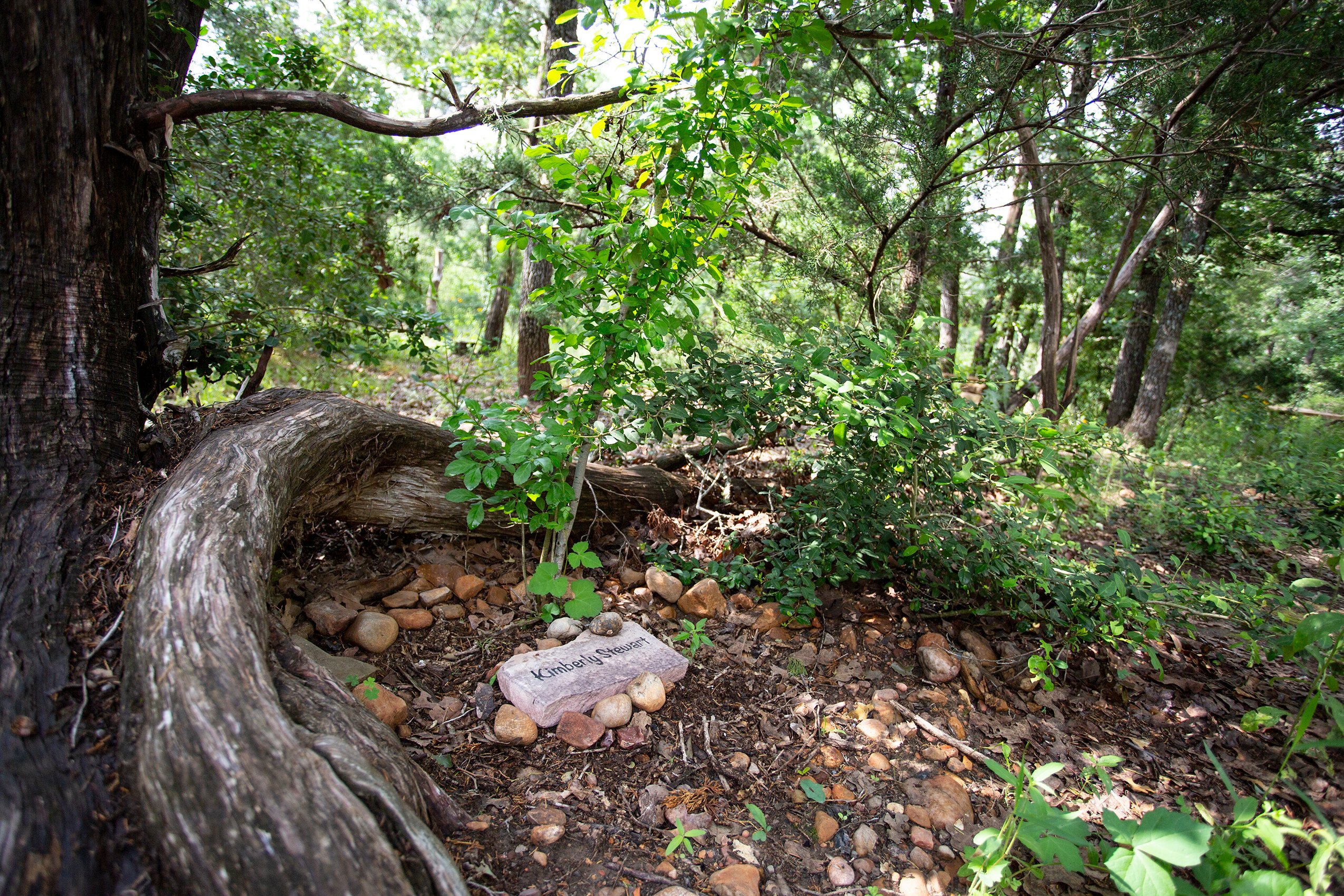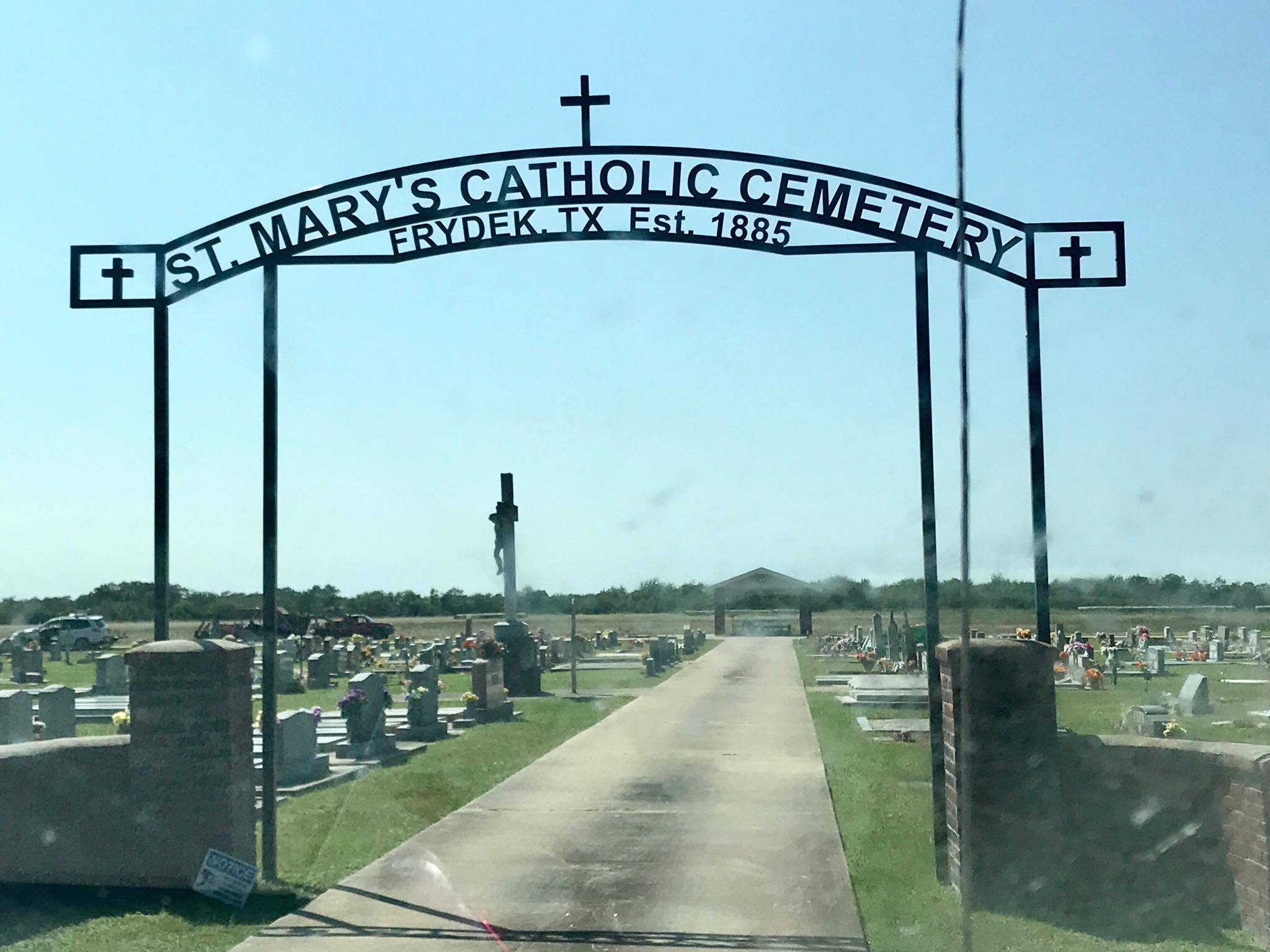
How to Die in Texas
The funeral industry has long been characterized by shady practices. In Texas, the bereaved are starting to look for new options.

A version of this story ran in the November / December 2020 issue.
Above: At the Eloise Woods Natural Burial Park in Bastrop, bodies are buried in biodegradable containers.
In 2017, in a tiny cemetery called St. Mary’s in a tiny Texas town called Frydek, Eric Keyes prepared to bury his mother.
She’d died two days earlier, at 2:30 p.m. on a Monday. It wasn’t a surprise—Keyes’ parents had moved with him to a house in Richardson, a Dallas suburb, five years prior so that he could take care of them as their health declined. When his mother’s dementia worsened and her condition diminished, Keyes, now 51, got ready.
He remembered a trip he and his mother had taken to the Czech Republic, where her family emigrated from, when he was still in college. During the trip, one of their traveling companions purchased a plain wood casket to bring home for when they died, planning to be buried in it—unembalmed and straight to the earth. Keyes was perplexed by what seemed to him an unusual custom; his mother was not. That’s just how they do it here, she’d told him.
“When we were sitting on the plane, my mom said, ‘Well, between me and you, I’d like to be buried like that myself. I never liked the idea of an open casket, people looking at me when I’m dead. And I sure as hell don’t want to be pickled,’” Keyes says, a tinge of humor in his Dallas twang. “That was my mom’s way of saying she didn’t want to be embalmed.”

According to the watchdog group Funeral Consumers Alliance (FCA), pre-pandemic, about 200,000 people die in Texas each year. The menu of options that exist for death care is rather remarkable. In addition to traditional funerals, homegoings, and cremations, Texans can opt to be buried in one of the state’s natural burial parks or choose one of numerous artful cremains (cremated remains): They can be turned into a diamond, become part of an artificial coral reef, or become a painting. Technically, no Texas law prohibits cremating at home.
Most people, though, choose to work with a funeral home—an industry long characterized by shady business practices like hiding prices and price gouging. It’s expensive to die. According to the National Funeral Directors Association (NFDA), funerals on average cost about $7,000, while cremations clock in at about $5,000 (with a viewing). But that can change dramatically based on where you go and who you work with.
Funeral homes in the United States also insert a degree of separation between a person’s loved ones and their body. In other cultures, families and friends are intimately involved in death. In Japan, for instance, entire hotels exist for family members to spend time with relatives who have died. The Toraja people of southwest Indonesia keep family members’ bodies in their homes until a funeral, a period that can last months or years. In Barcelona, bodies are encased in glass coffins so that families can spend time with the bodies before cremation or burial.
The American mode of dying is unique in the world, and it’s a relatively recent phenomenon. In many ways, the mainstream death care industry is a microcosm of the culture of the country itself: isolated. Driven more often by capital than by grief or healing. Mired in a false history. And—hopefully—evolving.
“It didn’t have that real macabre, kind of gloomy feel to it. And that meant a lot to me. That meant everything to me, in fact.”
Consumers are beginning to choose cheaper, more sustainable alternatives to traditional funerals. That includes direct cremation, or cremations without the bells and whistles of embalming or a service; home funerals, where family members or friends put on their own services; and natural burial, where bodies are placed in biodegradable coffins and buried directly in the earth, reducing the time required for decomposition.
As his mother’s condition worsened, Eric Keyes began paying installments on a plain cherry wood casket and researching how he could honor his mother’s wishes from decades earlier. He settled on a home funeral and natural burial. The day she died, Keyes picked up the casket and a little bit of dry ice and summoned his sister. Together, they lifted their mother from the bed and tucked her into her final resting place.
Forty-eight hours later, they rented an SUV and transported their mother’s body to Frydek, outside Houston. Pallbearers consisting of beloved friends and family carried his mother to her grave on a cloudless, blue afternoon. One of Keyes’ cousins played the accordion as they walked. The mood was joyful, Keyes said. The friends and family in attendance drank beer, sang, and ate traditional Czech food. The whole thing cost about $2,500.
“It was just a different vibe,” Keyes says. “It didn’t have that real macabre, kind of gloomy feel to it. And that meant a lot to me. That meant everything to me, in fact.”
*
In 1947, mortuary millionaire W.W. Chambers, famous for offering no-frills funerals and upselling people paying for services with welfare money, told Congress that the funeral industry is “the most highly specialized racket in the world. It has no standard prices; whatever can be charged and gotten away with is the guiding rule.”
Not much has changed since then, despite the passage of the Funeral Rule in 1984. The law, which is enforced by the Federal Trade Commission (FTC), requires homes to disclose prices and offer services à la carte, rather than exclusively in packages.
In a 2017 investigation, NPR found that funeral homes often refuse to disclose prices, sometimes in violation of federal law, and embed expensive add-ons in package deals. In June of this year, the FTC announced that after five months undercover, nearly 20 percent of the 90 funeral homes it had visited since 2018 failed to comply with the Funeral Rule. Four of the homes were in Beaumont.
“There are very few other retail purchases where you go online and you look at a provider’s website and you don’t see any pricing information,” says Joshua Slocum, executive director of the Funeral Consumers Alliance. “This is a holdover from the industry’s preference to keep prices hidden.”
“There are very few other retail purchases where you go online and you look at a provider’s website and you don’t see any pricing information.”
The funeral industry rakes in about $16.3 billion every year from 19,000 funeral homes, according to census figures cited by the NFDA. About one-fifth of that goes to the Houston-based Service Corporation International (SCI), the largest funeral and cemetery corporation in North America. The NPR investigation spotlighted SCI’s predatory practices, which included selling cremations at different prices under different brand names and refusing to disclose prices, although those practices are not uncommon at smaller, independent homes, either. As recently as 2019, the California attorney general sued one of SCI’s brands for misleading business practices. A representative from SCI said that a recent consumer survey found that 91 percent of clients rated the company’s clarity of pricing and payment as a 9 or higher on a 10-point scale. The representative also said that “different locations have different offerings,” and compared locations to rooms at a Ritz-Carlton and a Super 8 motel.
SCI was started by Houstonian Robert Waltrip, dubbed the “Merchant of Death” by Texas Monthly in 1996. Like many in the industry, Waltrip learned the trade from a family-run business—the Heights Funeral Home, which is still in operation. In 1962, Waltrip incorporated, and today, SCI runs nearly 2,000 funeral homes in North America under different names: Dignity Memorial, Funeraria Del Angel, Advantage Funeral & Cremation Services, Rose Hill, and Neptune Society.
Donate now to support independent, nonprofit journalism.“Ever since Waltrip started that ruckus in the early ’60s, monetizing grief and commoditizing the funeral experience—what’s happened since then is that our culture in the United States has evolved to where we think there’s only two ways to dispose of a body,” says Jim Bates, the Texas representative of the FCA. “One is to spend way too much money and get ripped off … or a pauper’s burial.”
Robert Waltrip has donated more than $1 million to state legislators and campaigns over the past 20 years, including $250,000 to Governor Greg Abbott’s campaign chest since 2016.
There’s the funeral industry. Then there’s the way we treat bodies after death.
Embalming, the pickling process Eric Keyes’ mother wanted to avoid, involves making a slice in a body’s neck near the carotid artery and draining the body of its blood through a small tube. The blood is then replaced with embalming fluid, a purple mixture of formaldehyde or glutaraldehyde, ethanol, water, humectants—substances used in food, cosmetics, medicines, and pesticides to maintain moisture—and other wetting chemicals. After embalming, funeral directors normally apply makeup and use clamps and glue to set a face in a pleasant expression. Embalming is rarely required by law, but most funeral homes require it if a visitation is planned.
Embalming is informed by a long, global history. Indigenous people in the Atacama Desert of northern Chile and southern Peru were the first to practice mummification; Egypt followed. Ancient Ethiopians, Central and South American civilizations, Tibetans, Nigerian tribes, and the Guanches of the Canary Islands all used embalming techniques on their dead. But as it’s practiced today, embalming is almost singular to the United States—few countries outside of the United States and Canada embalm their dead.
The practice was popularized in the United States during the Civil War to preserve soldiers’ bodies for the train home. At the same time, embalming became an integral part of death care for the Black community; embalming bodies is an important part of homegoings, the African American funerary tradition.
Still, there’s an enduring myth that embalming is a sanitary measure, one pushed forward by the funeral industry. “The primary purpose of embalming, all funeral men will tell you, is … the disinfecting of the body so that it is no longer a health menace,” journalist and civil rights activist Jessica Mitford wrote in her 1963 book, The American Way of Death. “Several writers for the trade, soaring to wonderful heights of fantasy, have gone so far as to attribute the falling death rate in this century to the practice of embalming.”
The fantasy has stuck around. According to the Texas Funeral Directors Association, embalming “sanitizes and preserves the body.” In most cases, however, dead bodies are not a source of disease or pathogens—including COVID-19. The Centers for Disease Control and Prevention recommends using personal protective equipment if a family plans to care for a body on its own; however, the agency says there is little risk of contracting the virus from a body.
“It’s the living who pose a danger to us of disease transmission,” Slocum says. “Coughing, breathing, excreting people. Dead bodies don’t breathe. They don’t cough. … The risk of transmission from a dead body is minimal to nonexistent.”
*
The way Americans view death is changing. There’s a different way to die.
In 2018, more people chose cremation over burial for the first time ever, according to the NFDA. At King-Tears Mortuary, the oldest funeral home in Austin, about 15 percent of services are now cremations. “The cremation rate has gone up because of financial reasons, as I see it,” says Stuart King, the director of the mortuary. “So we have to change the way we do business.”
Cremation, however, accounts for about 360,000 metric tons of carbon dioxide emissions each year in the United States, a representative for Matthews Environmental Solutions, a cremation technology manufacturer, told National Geographic in 2019.
Perhaps the most environmentally sustainable and financially accessible death care option is natural, or green, burial. This refers to death rituals and treatments that avoid using toxic chemicals or nonbiodegradable materials, according to the Green Burial Council. The FCA estimates that most green burials cost between $1,000 and $4,000.
“I think people are really hyperaware of climate change and environmental issues, and more and more people are taking that into account when they make end-of-life decisions.”
Natural burial is the oldest method of death care in the world, and it’s practiced in faith traditions like Judaism and Islam. But it’s only just starting to catch on in other U.S. cultures. Sarah Wambold, a funeral director who is working to open a natural cemetery in East Texas, says she’s seen interest grow over the past five years. In particular, she says, cremation firms are beginning to diversify their offerings to provide green burials.
“People have had a bad experience or an unfulfilling experience in the current funeral industry … and when they realize that this is an option, it’s such a gratifying experience that they want to seek it out for themselves,” she says. “I think people are really hyperaware of climate change and environmental issues, and more and more people are taking that into account when they make end-of-life decisions.”
Home funerals, where a family purchases a coffin and hosts a visitation in their own space, are on the rise, too. Jim Bates, the Texas FCA advocate, hosted a home funeral for his father when he died. “We had him up close and personal for four days,” Bates says. “He had all this accumulated stress and whatnot in his body. Over the four days, it was so good for me and my brother—we got to see and absorb all that being released. It felt so good. You don’t get that in an embalmed body.”
*
This summer, Eric Keyes’ father died. He was 91. Keyes knew what to do.
“My dad,” he says, “he was always going to follow my mom, do whatever she did anyway.”
Keyes bought the same kind of cherry wood casket he’d buried his mother in, and picked up his father’s body from the nursing home where he’d lived. Then he made the same phone calls, the same drive to the tiny St. Mary’s cemetery in tiny Frydek, and buried his father right next to his mother.
“It brought me so much peace to handle that that way,” he says. “You know, my parents were very, very, very frugal. And they just never believed in wasting anything. It was almost the ultimate way to honor them.
“And check this out,” he says. “I just bought me a plot.”
Read more from the Observer:
-
Bringing the Dead Home: Thirty years after Congress passed the Native American Graves Protection and Repatriation Act, only a fraction of human remains held by Texas’ museums and universities have been returned.
-
How We Got Here: Texas’ health system has been underfunded, understaffed, and unprepared for years. Here, COVID-19 found the perfect place to spread.
-
Quilts of Color: Laverne Brackens and her family carry on the interwoven legacy of Black quiltmakers in East Texas.


